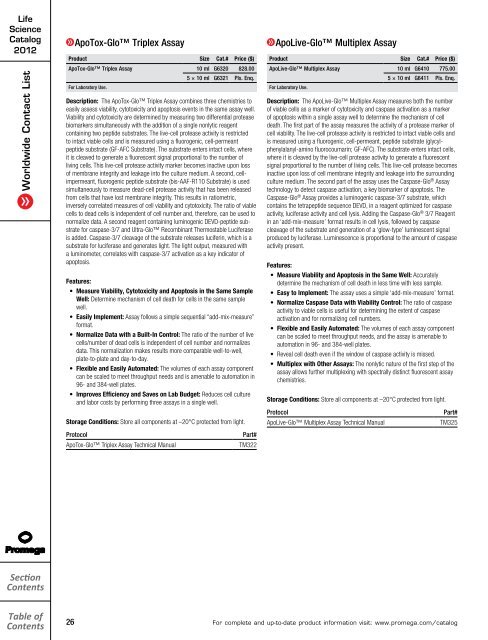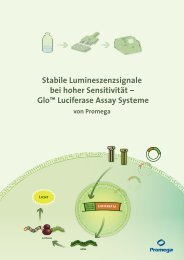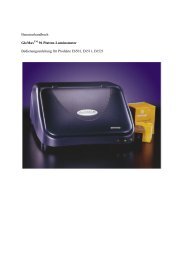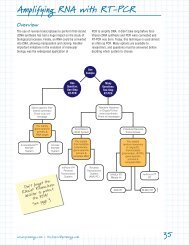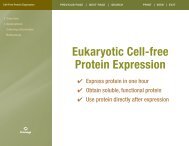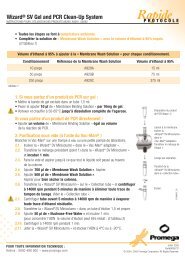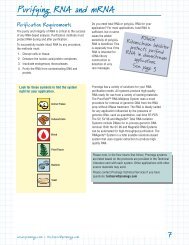Life Science - Promega
Life Science - Promega
Life Science - Promega
Create successful ePaper yourself
Turn your PDF publications into a flip-book with our unique Google optimized e-Paper software.
<strong>Life</strong><br />
<strong>Science</strong><br />
Catalog<br />
2012<br />
Worldwide Contact List<br />
Cell Signaling<br />
ApoTox-Glo Triplex Assay<br />
Product Size Cat.# Price ($)<br />
ApoTox-Glo Triplex Assay 10 ml G6320 828.00<br />
For Laboratory Use.<br />
5 × 10 ml G6321 Pls. Enq.<br />
Description: The ApoTox-Glo Triplex Assay combines three chemistries to<br />
easily assess viability, cytotoxicity and apoptosis events in the same assay well.<br />
Viability and cytotoxicity are determined by measuring two differential protease<br />
biomarkers simultaneously with the addition of a single nonlytic reagent<br />
containing two peptide substrates. The live-cell protease activity is restricted<br />
to intact viable cells and is measured using a fluorogenic, cell-permeant<br />
peptide substrate (GF-AFC Substrate). The substrate enters intact cells, where<br />
it is cleaved to generate a fluorescent signal proportional to the number of<br />
living cells. This live-cell protease activity marker becomes inactive upon loss<br />
of membrane integrity and leakage into the culture medium. A second, cellimpermeant,<br />
fluorogenic peptide substrate (bis-AAF-R110 Substrate) is used<br />
simultaneously to measure dead-cell protease activity that has been released<br />
from cells that have lost membrane integrity. This results in ratiometric,<br />
inversely correlated measures of cell viability and cytotoxicity. The ratio of viable<br />
cells to dead cells is independent of cell number and, therefore, can be used to<br />
normalize data. A second reagent containing luminogenic DEVD-peptide substrate<br />
for caspase-3/7 and Ultra-Glo Recombinant Thermostable Luciferase<br />
is added. Caspase-3/7 cleavage of the substrate releases luciferin, which is a<br />
substrate for luciferase and generates light. The light output, measured with<br />
a luminometer, correlates with caspase-3/7 activation as a key indicator of<br />
apoptosis.<br />
Features:<br />
• Measure Viability, Cytotoxicity and Apoptosis in the Same Sample<br />
Well: Determine mechanism of cell death for cells in the same sample<br />
well.<br />
• Easily Implement: Assay follows a simple sequential “add-mix-measure”<br />
format.<br />
• Normalize Data with a Built-In Control: The ratio of the number of live<br />
cells/number of dead cells is independent of cell number and normalizes<br />
data. This normalization makes results more comparable well-to-well,<br />
plate-to-plate and day-to-day.<br />
• Flexible and Easily Automated: The volumes of each assay component<br />
can be scaled to meet throughput needs and is amenable to automation in<br />
96- and 384-well plates.<br />
• Improves Efficiency and Saves on Lab Budget: Reduces cell culture<br />
and labor costs by performing three assays in a single well.<br />
Storage Conditions: Store all components at –20°C protected from light.<br />
Protocol<br />
ApoTox-Glo Triplex Assay Technical Manual<br />
Part#<br />
TM322<br />
ApoLive-Glo Multiplex Assay<br />
Product Size Cat.# Price ($)<br />
ApoLive-Glo Multiplex Assay 10 ml G6410 775.00<br />
5 × 10 ml G6411 Pls. Enq.<br />
For Laboratory Use.<br />
Description: The ApoLive-Glo Multiplex Assay measures both the number<br />
of viable cells as a marker of cytotoxicity and caspase activation as a marker<br />
of apoptosis within a single assay well to determine the mechanism of cell<br />
death. The first part of the assay measures the activity of a protease marker of<br />
cell viability. The live-cell protease activity is restricted to intact viable cells and<br />
is measured using a fluorogenic, cell-permeant, peptide substrate (glycylphenylalanyl-amino<br />
fluorocoumarin; GF-AFC). The substrate enters intact cells,<br />
where it is cleaved by the live-cell protease activity to generate a fluorescent<br />
signal proportional to the number of living cells. This live-cell protease becomes<br />
inactive upon loss of cell membrane integrity and leakage into the surrounding<br />
culture medium. The second part of the assay uses the Caspase-Glo ® Assay<br />
technology to detect caspase activation, a key biomarker of apoptosis. The<br />
Caspase-Glo ® Assay provides a luminogenic caspase-3/7 substrate, which<br />
contains the tetrapeptide sequence DEVD, in a reagent optimized for caspase<br />
activity, luciferase activity and cell lysis. Adding the Caspase-Glo ® 3/7 Reagent<br />
in an ‘add-mix-measure’ format results in cell lysis, followed by caspase<br />
cleavage of the substrate and generation of a ‘glow-type’ luminescent signal<br />
produced by luciferase. Luminescence is proportional to the amount of caspase<br />
activity present.<br />
Features:<br />
• Measure Viability and Apoptosis in the Same Well: Accurately<br />
determine the mechanism of cell death in less time with less sample.<br />
• Easy to Implement: The assay uses a simple ‘add-mix-measure’ format.<br />
• Normalize Caspase Data with Viability Control: The ratio of caspase<br />
activity to viable cells is useful for determining the extent of caspase<br />
activation and for normalizing cell numbers.<br />
• Flexible and Easily Automated: The volumes of each assay component<br />
can be scaled to meet throughput needs, and the assay is amenable to<br />
automation in 96- and 384-well plates.<br />
• Reveal cell death even if the window of caspase activity is missed.<br />
• Multiplex with Other Assays: The nonlytic nature of the first step of the<br />
assay allows further multiplexing with spectrally distinct fluorescent assay<br />
chemistries.<br />
Storage Conditions: Store all components at –20°C protected from light.<br />
Protocol<br />
ApoLive-Glo Multiplex Assay Technical Manual<br />
Part#<br />
TM325<br />
Section<br />
Contents<br />
Table of<br />
Contents<br />
26<br />
For complete and up-to-date product information visit: www.promega.com/catalog


